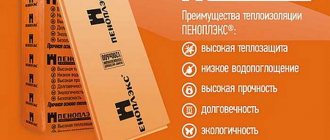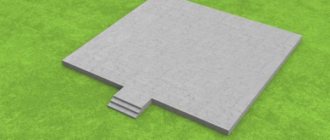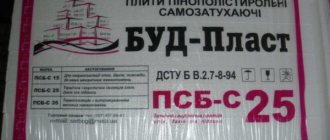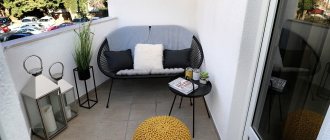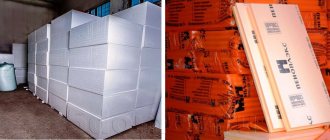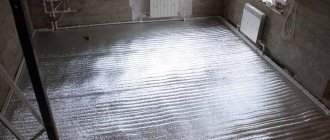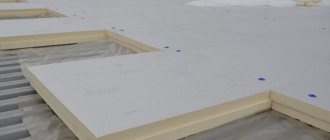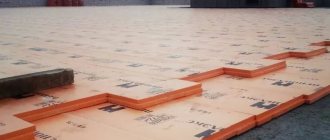No construction is complete without the use of insulating materials. Houses are often insulated using foamed polymers, the production method of which raises controversy about fire safety. Everyone knows about expanded polystyrene, synonymous with the brand Penoplex; Whether this material burns or not worries many owners who choose insulation for their home. Let's take a closer look at the properties of expanded polystyrene (EPS), examine its flammability and find out how dangerous it is in a fire.
Opinions about the dangers of polystyrene foam insulation vary widely Source lalafo.com
About the material
Expanded polystyrene belongs to foam plastics, a class of materials that are foamed (cellular) plastic masses. It was first produced on an industrial scale in Germany in 1937; in the USSR production began two years later.
The raw materials for EPS are polystyrene and other polymers. The technological process is based on saturating the polymer mass with a foaming agent, followed by heating the mass with steam. As a result, polystyrene granules increase in volume, fill the mold and are sintered, forming the shape of the finished product.
There is another technology when processes take place at elevated temperature and pressure. The foamed mass is squeezed out of the extruder, and the material obtained by extrusion is called extruded (or extruded) polystyrene foam. Both materials are synthetics, which are flammable.
The final stage of production of EPS boards Source piramida-stroi.ru
Manufacturers
There is fierce competition in the construction market, however, not as many companies are involved in the production of technoplexes as the consumer would like. Let's consider the list of the main suppliers of extruded insulation on the Russian market.
TECHNONICOL. The company is among the TOP 100 largest enterprises in Russia, and has several production lines in the country. The manufactured products attract buyers with a relatively low price and high quality.
URSA. A relatively young brand that appeared on the market in 2003. At the beginning of its development, the company was engaged in the production of mineral wool from fiberglass. After merging with the Spanish company URALITA, lines for the production of extruded polystyrene began operating. Now it is one of the leading European brands, actively developing the Russian building materials market.
RAVATHERM. The trademark belongs to a Belgian company with production lines in the Moscow region. Finished products are subject to multi-stage quality control, so they invariably have high technical characteristics.
It is worth noting that the products of these enterprises have international certificates and are absolutely environmentally safe.
Degrees of flammability of building materials
Homeowners make their choice of material for home insulation based on various considerations. Some, with a limited budget, focus on cost; for others, simple installation is important. However, everyone, one way or another, pays attention to the fire resistance and environmental friendliness of the construction material.
On the Internet there are different, often mutually exclusive, opinions about the flammability of expanded polystyrene and penoplex in particular. To figure out where the truth lies, you need to start with the official classification of flammability.
Flammability classes (as well as methods for testing construction mats for susceptibility to fire) are established on the basis of documentation GOST 30244-94. The classification is used in the future to ensure fire safety. Building materials are exposed to fire and, depending on their behavior, are divided into two types: combustible (G) and non-combustible (NG). Combustible construction mats, in turn, form the following groups:
- Low flammability (G1). Such materials do not burn (extinguish) on their own, the degree of destruction does not exceed 20%, and the flue gases do not heat above 135°.
Fire hazard properties of building materials Source wp.com
- Moderately flammable (G2). Materials of this group are capable of burning on their own for no more than 30 seconds, while they are destroyed by fire by no more than 50%, and the gases do not heat above 235°.
- Normally flammable (G3). No more than 300 seconds pass before attenuation, while the gases have time to heat up to a maximum of 450°, and the material has time to collapse by 50%.
- Highly flammable (G4). Self-combustion lasts longer than 5 minutes, other parameters exceed the values of the previous paragraph.
Building materials are also classified according to other properties, for example, flammability, smoke-generating ability, and toxicity of combustion products. Each of these properties is divided into groups. For example, the flammability of building materials is divided into the following categories: hardly flammable (B1), moderately flammable (B2), flammable (B3).
EPS without fire retardant additives is a highly flammable material Source pro-uteplenie.ru
See also: Catalog of companies that specialize in home insulation
Polystyrene foam or stone wool: a difficult choice of insulation
Let’s say right away that there are no bad insulation materials; there are materials that are out of place or installed with gross construction errors. This is where all the problems come from. But the debate over choosing the best type of insulation does not subside. Let's look at the reasons for using polystyrene foam in a frame wall .
Antipov IgorBuilder and FORUMHOUSE user
I don’t understand why mineral wool is most often recommended for insulating frame houses. In my opinion, expanded polystyrene is superior to mineral wool insulation in all respects! They say that rodents make holes in polystyrene foam, but you can protect yourself from this. I have seen more than once how mice made nests in mineral wool laid in the attic. My reasons for foam plastic:
- Expanded polystyrene is cheaper than mineral wool.
- It surpasses mineral wool in thermal performance.
- Polyfoam practically does not absorb moisture, so there is no need for vapor barrier.
- Dimensional stability.
- Polystyrene foam is more durable than cotton wool and does not lose its properties over time.
It seems to me that when choosing insulation, we follow the lead of marketers, but what do you think?
WiktarFORUMHOUSE Member
I also vote for polystyrene foam. In terms of safety indicators, it is in no way inferior to mineral wool. And mice eat all types of insulation. I insulated my bathhouse, except for the steam room, with polystyrene foam and I don’t regret it at all.
Let us add that the “myth” that rodents eat polystyrene plastic is firmly entrenched in the minds of novice developers. Mice and rats don't actually They make passages in insulation - both foam plastic and mineral wool - in search of food in the house or make nests for breeding.
katogaFORUMHOUSE Member
In my shed there was a roll of mineral wool insulation and foam plastic in the slabs. So, over the winter the mice tore the cotton wool into shreds, but did not touch the foam.
YuryCivil engineer, FORUMHOUSE user
I insulated my dacha with polystyrene foam 15 cm thick. Heat loss is minimal, there are no odors, it’s cool in the summer, and in general it’s comfortable. I recently checked the insulation - I made an opening in the wall. For 7 years, the foam has not changed at all. The internal lining is imitation timber. I installed it without a gap or vapor barrier. The wood is also in perfect condition. Sheets of PPS were placed tightly, with force, between the racks. Didn't blame anything. The main thing is to mark everything accurately and cut the foam not with a hacksaw, but with a sharp knife. The slabs, 5 cm thick, were bandaged in layers. Outside, just in case, I installed waterproofing.
GoryachevFORUMHOUSE user
I chose expanded polystyrene as the most effective insulation inside the building envelope. Polystyrene foam does not dampen, is easy to install and is inexpensive. The only negative for me is that polystyrene foam is a poor sound insulator. I don’t believe in the “myths” about rodents, the toxicity and fragility of polystyrene foam. I think this is due to the incorrect use of the material, the choice of low-quality foam plastic and the good audibility of mice if they swarm around in walls insulated with foam plastic.
Now let’s look at the arguments “FOR” mineral wool in frames. It has already been said above that polystyrene foam is a poor sound insulator. And it is true.
Serg_ASUser FORUMHOUSE
The advantage of stone wool is that it provides better sound insulation than expanded polystyrene.
Antipov Igor
But I would argue with this statement! Those who are familiar with frames insulated with mineral wool know well that everything can be heard quite well through the walls of the house. I once insulated a frame partition with 10 cm thick “cotton wool” and covered it with plasterboard on both sides. Imagine my surprise and disappointment when it turned out that the old partition, made of thin logs, let in less sounds.
StarperFORUMHOUSE user
I'll add my two cents against foam plastic. I was insulating an old dacha and saw what was left of the polystyrene foam. Everything was chewed up by mice. Moreover, they were running right under our feet. After I laid high-quality mineral wool, the rodents disappeared. She's prickly. I saw a place where mice wanted to get into the house. They pulled out a piece of mineral wool, but didn’t go any further.
RECORDYA member of FORUMHOUSE
I heard that polystyrene foam is harmful to health and should not be used as insulation in residential areas. I wouldn’t live in a “plastic” house!
nikola032FORUMHOUSE Member
I'm building a frame house. I insulated the ceiling between the second floor and the roof with polystyrene foam. First, I laid 15 cm of polystyrene foam between the beams in three layers of 5 cm each. I filled the bars with a cross-section of 50 mm perpendicularly and laid another 5 cm of polystyrene foam and laid the boards. My observation is that as soon as the sun comes out and the attic heats up, there is a terrible stench coming from the foam. They covered it with film. Did not help. The seams between the beams and polystyrene slabs were sealed with foam. This increases the cost and increases the construction period. It is also unclear how wood covered with foam will behave over time. When sawing foam plastic, a lot of debris is generated. My verdict is that there is no point in using polystyrene foam inside the house. Its scope of application is external insulation!
Flammability degree of PPS
Stories about non-flammable polystyrene foam do not correspond to reality, as evidenced by the G4 flammability class assigned to it. And, although it will not ignite from a burning cigarette butt, sparks from a sharpening tool or a red-hot knife blade, the cause of ignition may well be a lit match, the flame of a blowtorch or a spark from an autogen. The combustion of EPS is described by the following characteristics:
- The ignition temperature lies in the range of 210-440°C, the difference is determined by the composition of a particular modification of the synthetic.
- The flame temperature rises to 1200°C in a short time, so the material can intensify the fire.
- Combustion is accompanied by the formation of toxic smoke, the composition of which also depends on impurities. The volume of toxic products released (hydrogen cyanide, hydrogen bromide) is 36 times greater than the volume of emissions from burning wood.
Expanded polystyrene of flammability class 4 suffers from all these properties; for obvious reasons, it does not have approval certificates for use in construction.
If you remove the source of the flame, the fire goes out. Source ytimg.com
The answer to the question whether penoplex burns will also be positive, although this property is assessed according to class G3-G4. Many manufacturers reduce the degree of flammability and combustion temperature by adding fire retardants; There are additives that reduce the intensity of smoke formation. In most cases, the effect is achieved by replacing the gas mixture during the production process: the volume is increased not with fuel, but with carbon dioxide.
Thermal conductivity
EPS and EPS have low, and therefore good, thermal conductivity. The extruder, due to its denser structure, is slightly ahead in this parameter. A 50 mm sheet insulates a room better than a half-meter thick concrete wall. This is an effective material, on par with mineral wool.
Note: UV protection and adhesion
Polystyrene foam is afraid of ultraviolet radiation. It must be covered with another material on top: plaster, if we are talking about a facade, or a roofing covering together with a waterproofing membrane, if the roof is insulated.
EPS and EPS are very smooth, so in order to improve the surface in terms of adhesion, before applying the glue, you need to damage the top layer with very rough sandpaper or scratch it with a hacksaw. Otherwise, over time, the plaster will slip and fall off.
Another reliable option is to glue a reinforced mesh onto the insulation with alkaline glue, and then apply plaster on it.
About labeling and legislative subtleties
Until 2009, flammable PPS, to which flame retardants were added, received the G1 marking. In May 2009, federal law FZ-123 “Technical Regulations on Fire Safety Requirements” came into force. He changed the method by which building materials were distributed into flammability groups.
Based on the totality of their characteristics, all polystyrene-based insulation materials are now classified no higher than G3. This is due to the fact that, according to the new rules, materials of groups G1-G2 cannot form melt drops.
Expanded polystyrene boards are approved for use in construction Source 1-teplodom.ru
Penoizol - polystyrene foam based on urea-formaldehyde
In addition to polystyrene, other polymers are also used in the production of foam plastics. Material based on urea-formaldehyde has become widespread. It is more often called penoizol. The production of penoizol is quite complex, and in our country it was not widely used in construction until the 90s of the last century.
The process of making penoizol consists of creating foam and enveloping the cells with karmamide resin. The material hardens within 2-3 days and acquires excellent characteristics - the material is quite dense and has low thermal conductivity.
Penoizol is produced in the form of standard slabs, but is most often used in construction work in a liquid state - during the preparation process at the workplace. This has great advantages in terms of installation work:
- Filling the hardest-to-reach places with thermal insulation
- There is no need for preliminary calculations for the purchase of materials
- No additional fasteners
However, the use of penoizol during the construction process requires special equipment. It is clear that in this case, only specialized teams can carry out the insulation work.
Spraying penoizol requires special equipment
How dangerous is penoplex?
Misunderstandings often arise between sellers and buyers. When a buyer is interested in whether penoplex is a flammable material or not, the seller can say that the insulation is a fire-resistant building material. He will be right if the slabs belong to classes G1-G3, and a fire-retardant impregnation is added to them, making the material self-extinguishing.
However, even in this case, the polymer will not withstand fire: the surface will melt and combustion products will enter the air. And, although the technology for producing EPS has been improved, and flammable gas has been replaced with carbon dioxide, the health hazard still remains. When burning, among other things, soot and hydrogen chloride are released, and their inhalation can cause an attack of suffocation, and in rare cases, pulmonary edema.
Therefore, foamed EPS can be classified as non-flammable only conditionally, implying its good fire resistance. Buyers often take the name literally and believe that the seller is deceiving them, although they interpret the same concept in different ways.
Expanded polystyrene emits smoke in any case Source yandex.net
“Velit” insulation made of porous concrete D-140
A very good and promising heat insulator, which is used to insulate house facades, flat roofs, floors, and ceilings. What does he imagine himself to be? Velit is porous concrete D-140 (for understanding, I can say that one cubic meter of this material weighs only 140 kg) is non-flammable.
It does not have a flammability class, it is simply not standardized by class, it is NG, which means non-flammable. Since this insulation is porous concrete, in principle it cannot burn, and there is nothing you can add here.
Briefly about the main thing
Artificial materials always raise concerns in terms of their fire safety. The danger that a particular building material can pose is regulated by regulatory documents, and each building material is assigned certain characteristics: the degree of flammability, toxicity of combustion products, smoke-generating ability.
Initially, EPS had a maximum degree of flammability, but then they began to reduce it using fire retardant additives. Modified (self-extinguishing) insulation is allowed to be used in construction, provided that the installation rules are followed. But even in this case, the surface of the polymer melts under the influence of fire, and toxic substances enter the air.
Description
Density
High-quality EPS has a homogeneous structure and closed pores of a much smaller size than conventional polystyrene foam (no more than 0.2 mm). Due to its increased compressive density, EPS can be used where foam plastic is too soft. Extruded polystyrene foam can withstand a load of 35 tons per 1 m2!
Installation work
Another advantage that this material structure provides is the ability to process it comfortably. Many people know how difficult it was to cut foam plastic. The balls crumbled, scattered and became magnetized to hands, tools and surfaces. And even with careful handling, the slab could crack and break in the wrong place.
House insulation with Penoplex
Extruded polystyrene foam is free of all these disadvantages. It is easy to cut with a regular hacksaw. The cut is precise and even. And the slabs are laid directly on the base - no additional layers of steam and waterproofing are required. The joints are sealed with polyurethane foam. EPS does not emit toxic substances or unpleasant odors. Working with it does not require special equipment for installers.
Moisture absorption
The dense structure increased the moisture resistance of the material (against the background of vulnerable mineral wool, water absorption of 0.2 looks like an error). In the first 10 days, the side cells on the cut collect a minimal amount of moisture. Then water absorption stops, water does not pass inside.
Thermal conductivity
In the battle to retain heat, even a slight difference in thermal conductivity matters. For different brands of expanded polystyrene, this figure ranges from 0.037 to 0.052 W/(m* °C). Extruded polystyrene foam has an indicator of 0.028 - 0.03 W/(m* °C)!
Chemical resistance
XPS has proven to be resistant to:
- various acids (organic and not);
- salt solutions;
- ammonia;
- cement and concrete;
- lime;
- alkalis;
- alcohol dyes, alcohol;
- carbon dioxide, oxygen, acetylene;
- freons (fluorinated hydrocarbons);
- paraffin;
- water and water-based paints;
- bacteria and fungi.
Other properties
The thickness of the produced slabs can be from 2 to 12 cm.
For ease of installation, three types of edges are available:
- Straight.
- With the selected quarter (marked with the letter S).
- Tenon - groove (letter N on the marking).
The outer surface can be smooth or corrugated (indicated by the letter G on the marking).
The color range of extruded polystyrene foam is varied. There are no uniform standards yet, so each manufacturer produces slabs of different sizes, thicknesses and different colors to indicate different quality EPS.
The properties of EPS do not change even after 1000 freezing-thawing cycles, or after prolonged immersion in water. Extruded polystyrene foam remains unchanged even in conditions of -60 +85 °C!
Orange slabs
Cons and weaknesses:
- Penoplex is vulnerable to solvents, some gases (methane), petroleum jelly, tar, gasoline, oil and fuel oil.
- Susceptible to destruction upon contact with polyvinyl chloride (siding).
- Flammability. It corresponds to the level of flammability of wood, but all foam plastics emit toxic substances when melted that suffocate a person faster than carbon monoxide.
- The material must be protected from direct exposure to ultraviolet radiation (not used open).
- There are temperature restrictions when insulating baths, saunas and fire pits. The surface should not be heated above +75 °C.
- Just like polystyrene foam, extruded polystyrene foam can be damaged by rodents. They don't eat it, but grind it up and build nests in it.
There are no ideal materials, therefore, knowing about its shortcomings, you need to be able to adjust technologies to suit them. For example, in order to protect residents in case of fire, it is not recommended to use EPS for internal insulation of ceilings, and plastering should be done on top of the insulation layer.
To protect the wall from rodents, Penoplex slabs can be covered with fine mesh.
